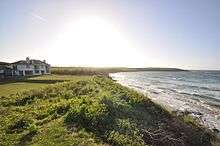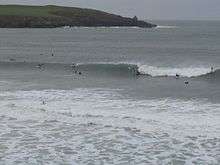Harlyn
Coordinates: 50°32′17″N 4°59′49″W / 50.538°N 4.997°W



Harlyn (Cornish: ar-Lyn, meaning facing a pool) is a small village on the north coast of Cornwall, England, United Kingdom. It is situated inland from Harlyn Bay (Cornish: Porth Lys, meaning court cove) three miles from Padstow and about one mile from St. Merryn.[1]
Harlyn Bay is a family and surfing beach and is suitable for novice surfers. Near the beach are a caravan park and a pub called The Harlyn Inn. Many of the houses in Harlyn are holiday lets. East of Harlyn Bay is the village and beach of Trevone and west of Harlyn are Cataclews Point (Cornish: Karrek Loos, meaning grey rock), Mother Ivey's Bay and Trevose Head. Further west, the beaches at Constantine Bay, Porthcothan and Treyarnon are linked by the South West Coast Path.
Harlyn lies within the Cornwall Area of Outstanding Natural Beauty (AONB). Almost a third of Cornwall has AONB designation, with the same status and protection as a National Park.
The village is comprised to a large extent of second homes, and is quiet for much of the year.
The Gold Lunulae of Harlyn
In 1865 a labourer found two wafer-thin crescents of gold known as lunulae at Harlyn Bay. They probably date from the early Bronze Age, and were probably deposited as grave goods, as there are several prehistoric burial mounds nearby. The shape of these lunulae indicates a symbolic meaning. They represent the crescent horns of the moon, and may thus have been objects of great ritual and ceremonial significance.[2] The site of the finds was above Onjohn Cove, a small cove between Harlyn Bay and Cataclews Point at grid reference SW 872 759.
In 2014, after heavy storms had battered the cliffs of Harlyn Bay, local residents and beach users discovered the storms had uncovered an ancient burial cist containing human remains.[3] The remains were recovered for further investigation, but it is assumed that they belong to a female from with Iron or Bronze age periods.
References
- ↑ Ordnance Survey: Landranger map sheet 200 Newquay & Bodmin ISBN 978-0-319-22938-5
- ↑ Golden treasures from Cornwall’s past by Cheryl Straffon
- ↑ "Storms expose ancient human remains on Harlyn Bay near Padstow". Cornish Guardian. Retrieved 2016-03-15.
External links
![]() Media related to Harlyn at Wikimedia Commons
Media related to Harlyn at Wikimedia Commons